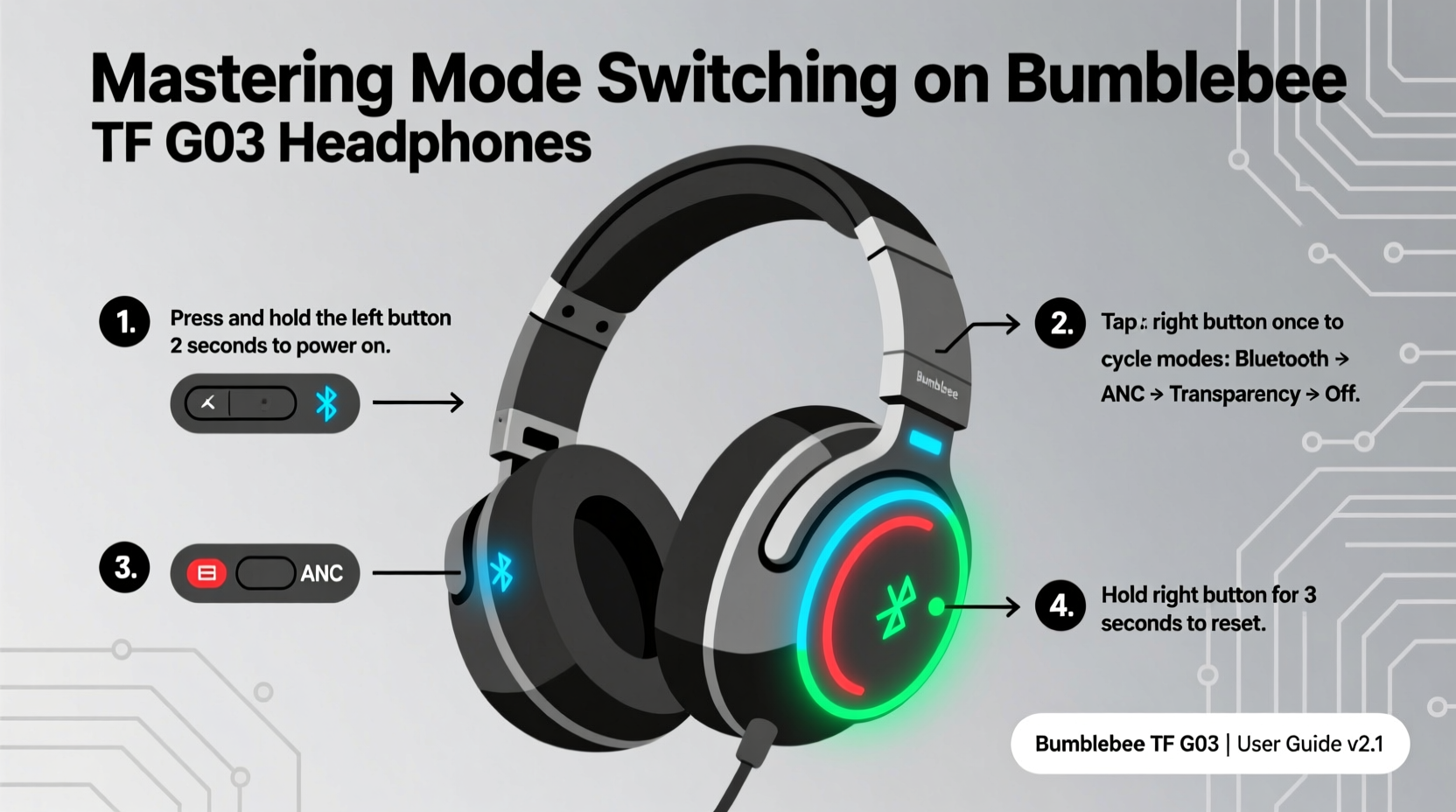The Bumblebee TF G03 headphones offer a versatile audio experience, combining wireless freedom with multi-device compatibility and customizable sound modes. However, many users underutilize their potential simply because they haven’t fully grasped how to switch between operating modes effectively. Understanding the different modes—Bluetooth pairing, wired listening, gaming latency reduction, and multipoint connectivity—can dramatically improve your daily use. This guide breaks down each mode, explains when to use it, and provides precise steps for seamless transitions.
Understanding the Modes Available on TF G03

The Bumblebee TF G03 supports four primary operational modes: standard Bluetooth, low-latency gaming mode, wired audio mode, and multipoint connection mode. Each serves a distinct purpose and is optimized for different scenarios.
- Standard Bluetooth Mode: Ideal for everyday music, calls, and general media consumption.
- Low-Latency Gaming Mode: Reduces audio delay for gaming or video watching where sync matters.
- Wired Mode: Uses the included 3.5mm cable for uninterrupted audio, especially useful when battery is low.
- Multipoint Mode: Allows simultaneous connection to two devices (e.g., phone and laptop).
Familiarity with these modes ensures you’re not just using the headphones—you're optimizing them.
Step-by-Step Guide to Switching Between Modes
Navigating between modes on the TF G03 doesn’t require an app or complicated settings. Everything is handled through button combinations and physical switches. Follow these sequences carefully.
Switching to Low-Latency Gaming Mode
- Power on the headphones in standard Bluetooth mode.
- Press and hold the Volume Up and Play/Pause buttons simultaneously for 3 seconds.
- A voice prompt will announce “Game mode on.” The LED may blink white rapidly.
- Latency drops from ~180ms to under 60ms, ideal for fast-paced games or real-time video editing.
Activating Multipoint Connection
- Ensure both devices have Bluetooth enabled.
- Pair the headphones with the first device as usual.
- Hold the Power and Volume Down buttons together until the LED flashes red and blue alternately.
- Release and pair with the second device.
- To switch audio sources, pause playback on the active device and start on the other.
Using Wired Mode
- Connect the 3.5mm audio cable to the headphone’s input jack.
- Plug the other end into your device.
- No power is needed—the headphones function passively.
- Note: Microphone and controls won’t work in wired mode unless using an inline-mic cable.
“Proper mode management can extend effective battery life by up to 30% by reducing unnecessary background processing.” — Lin Zhao, Audio Hardware Engineer at SoundLogic Labs
Mode Comparison Table: When to Use Which
| Mode | Best For | Battery Impact | Audio Quality |
|---|---|---|---|
| Standard Bluetooth | Music, podcasts, calls | Normal (up to 30 hrs) | Good (AAC/SBC codec) |
| Low-Latency Gaming | Gaming, live streaming | High drain (~18 hrs) | Slightly compressed, but synchronized |
| Wired Mode | Battery conservation, studio monitoring | No battery used | Highest fidelity (analog signal) |
| Multipoint | Work setups, dual-device users | Moderate increase (~24 hrs) | Good, with occasional brief dropouts during switching |
Real-World Example: A Remote Worker’s Setup
Sophie, a digital project manager based in Lisbon, uses her TF G03 headphones across three contexts daily. In the morning, she listens to audiobooks in standard Bluetooth mode while commuting. At her desk, she activates multipoint mode to stay connected to both her work laptop (for Zoom) and personal phone (for messages). During evening gaming sessions, she toggles into low-latency mode via the volume-up/play shortcut. When her battery dips below 20%, she switches to wired mode using the supplied cable, ensuring uninterrupted focus without charging delays. By mastering mode switching, Sophie extends functional usage to nearly 14 hours a day across multiple applications—without performance hiccups.
Essential Checklist for Efficient Mode Management
To ensure smooth operation and avoid confusion, follow this checklist whenever setting up or switching modes:
- ✅ Confirm firmware is updated (via manufacturer’s website if applicable).
- ✅ Power cycle the headphones after failed pairing attempts.
- ✅ Use the correct button combo for desired mode—double-check before holding.
- ✅ Disconnect unused paired devices to reduce connection clutter.
- ✅ Store in protective case when not in use, especially in multipoint environments.
- ✅ Clean the audio jack regularly to maintain reliable wired connections.
Frequently Asked Questions
Can I receive calls in gaming mode?
Yes, incoming calls will still connect, but exiting gaming mode temporarily disables low-latency optimization. The headphones automatically revert to standard Bluetooth during calls unless manually reset afterward.
Why won’t my headphones reconnect in multipoint mode?
This often occurs when one device has Bluetooth priority locked. Try forgetting the headset on the less-used device and re-pairing. Also, ensure neither device is in airplane mode or has Bluetooth throttled by battery-saving settings.
Does wired mode support surround sound?
No. The analog 3.5mm input only transmits stereo signals. Virtual surround features are processed internally and require powered operation, so they’re unavailable in passive wired mode.
Final Tips for Long-Term Performance
Consistent mode switching shouldn’t come at the cost of hardware strain. Avoid rapid, repeated button presses, which can wear out tactile switches over time. Instead, press deliberately and allow 2–3 seconds between commands. Keep the user manual handy—even experienced users benefit from a quick reference. Additionally, resetting the headphones monthly (by holding Power + Volume Down for 10 seconds) clears cached connections and improves mode-switching reliability.









 浙公网安备
33010002000092号
浙公网安备
33010002000092号 浙B2-20120091-4
浙B2-20120091-4
Comments
No comments yet. Why don't you start the discussion?